Effect of Packaging and Salt Content and Type on Antioxidant and ACE-Inhibitory Activities in Requeson Cheese
Abstract
:1. Introduction
2. Materials and Methods
2.1. Materials
2.2. Requeson Cheese Preparation
2.3. Experimental Design
2.4. Water Soluble Extract (WSE) Preparation
2.5. Antioxidant Activity
2.6. Proteolysis
2.7. Peptide Concentration
2.8. ACE Inhibitory Activity
2.9. Statistical Analysis
3. Results and Discussion
3.1. Antioxidant Activity
3.1.1. ABTS Methodology
3.1.2. DPPH Methodology
3.2. Proteolysis
3.3. Peptide Concentration
3.4. ACE Inhibitory Activity
3.5. Correlations
4. Conclusions
Author Contributions
Funding
Institutional Review Board Statement
Informed Consent Statement
Data Availability Statement
Acknowledgments
Conflicts of Interest
References
- WHO. Cardiovascular Diseases. 2021. Available online: https://www.who.int/news-room/fact-sheets/detail/cardiovascular-diseases-(cvds) (accessed on 5 February 2022).
- Hsieh, C.C.; Hernández-Ledesma, B.; Fernández-Tomé, S.; Weinborn, V.; Barile, D.; De Moura Bell, J.M.L.N. Milk proteins, peptides, and oligosaccharides: Effects against the 21st century disorders. Biomed. Res. Int. 2015, 2015, 146840. [Google Scholar] [CrossRef] [PubMed]
- González de la Cruz, O.; Rodríguez-Arias, O. Hipertensión arterial. MEDISAN. 1998, 2, 38–43. [Google Scholar]
- FDA. Food Facts from the U.S. Sodium in Your Diet: Use the Nutrition Facts Label and Reduce Your Intake. 2018. Available online: http://www.fda.gov/educationresourcelibrary (accessed on 29 January 2022).
- Adrogué, H.J.; Madias, N.E. Sodium and potassium in the pathogenesis of hypertension. N. Engl. J. Med. 2007, 356, 1966–1978. [Google Scholar] [CrossRef] [Green Version]
- Monckeberg, F. La sal es indispensable para la vida, ¿pero cuánta? Rev. Chil. Nutr. 2012, 39, 192–195. [Google Scholar]
- Ricci, I.; Artacho, R.; Olalla, M. Milk protein peptides with angiotensin I-Converting enzyme inhibitory (ACEI) activity. Crit. Rev. Food Sci. Nutr. 2010, 50, 390–402. [Google Scholar] [CrossRef] [PubMed]
- Sieber, R.; Bütikofer, U.; Egger, C.; Portmann, R.; Walther, B.; Wechsler, D. ACE-inhibitory activity and ACE-inhibiting peptides in different cheese varieties. Dairy Sci. Technol. 2010, 90, 47–73. [Google Scholar] [CrossRef]
- Madureira, A.R.; Tavares, T.; Gomes, A.M.P.; Pintado, M.E.; Malcata, F.X. Invited review: Physiological properties of bioactive peptides obtained from whey proteins. J. Dairy Sci. 2010, 93, 437–455. [Google Scholar] [CrossRef] [Green Version]
- Mulero-Cánovas, J.; Zafrilla-Rentero, P.; Martínez-Cachá Martínez, A.; Leal-Hernández, M.; Abellán-Alemán, J. Péptidos bioactivos. Clínica Investig. Arterioscler. 2011, 23, 219–227. [Google Scholar] [CrossRef]
- Carrasco, C.A.; Guerra, M. Lactosuero como fuente de péptidos bioactivos. An. Venez. Nutr. 2010, 23, 42–49. [Google Scholar]
- Mullally, M.M.; Meisel, H.; FitzGerald, R.J. Angiotensin-I-converting enzyme inhibitory activities of gastric and pancreatic proteinase digests of whey proteins. Int. Dairy J. 1997, 7, 299–303. [Google Scholar] [CrossRef]
- Grażyna, C.; Hanna, C.; Adam, A.; Magdalena, B.M. Natural antioxidants in milk and dairy products. Int. J. Dairy Technol. 2017, 70, 165–178. [Google Scholar] [CrossRef]
- Fox, P.F.; Uniacke-Lowe, T.; McSweeeney, P.L.H.; O’Mahony, J.A. Milk Proteins. In Dairy Chemistry and Biochemistry; Springer International Publishing: Cham, Switzerland, 2015; pp. 145–240. [Google Scholar]
- Darkwa, J.; Mundoma, C.; Simoyi, R.H. Reactivity and oxidation of dl-cysteine by some common oxidants. J. Chem. Soc. Faraday Trans. 1998, 94, 1971–1978. [Google Scholar] [CrossRef]
- Brosnan, J.T.; Brosnan, M.E. The sulfur-containing amino acids: An overview. J. Nutr. 2006, 136, 1636S–1640S. [Google Scholar] [CrossRef] [PubMed] [Green Version]
- Morozova, O.B.; Yurkovskaya, A.V. Modulation of the rate of reversible electron transfer in oxidized tryptophan and tyrosine containing peptides in acidic aqueous solution. J. Phys. Chem. B 2015, 119, 140–149. [Google Scholar] [CrossRef]
- Kinsella, J.E.; Whitehead, D.M. Proteinsin Whey: Chemical, Physical, and Functional Properties. In Advances in Food and Nutrition Research; Academic Press, Inc.: Cambridge, MA, USA, 1989; pp. 343–438. [Google Scholar]
- Inda, A.E. Performance Optimization and Safety Assurance in the Cheese Industry; Organization of American States (OEA): Saltillo, Mexico, 2000. [Google Scholar]
- Wade, A.M.; Tucker, H.N. Antioxidant characteristics of L-histidine. J. Nutr. Biochem. 1998, 9, 308–315. [Google Scholar] [CrossRef]
- Kim, J.; Paik, H.D.; Yoon, Y.C.; Park, E. Whey protein inhibits iron overload-induced oxidative stress in rats. J. Nutr. Sci. Vitaminol. 2013, 59, 198–205. [Google Scholar] [CrossRef] [Green Version]
- Hernández-Ledesma, B.; Recio, I.; Amigo, L. β-Lactoglobulin as source of bioactive peptides. Amino Acids. 2008, 35, 257–265. [Google Scholar] [CrossRef]
- Shahidi, F.; Zhong, Y. Novel antioxidants in food quality preservation and health promotion. Eur. J. Lipid Sci. Technol. 2010, 112, 930–940. [Google Scholar] [CrossRef]
- Ricci-Cabello, I.; Olalla-Herrera, M.; Artacho, R. Possible role of milk-derived bioactive peptides in the treatment and prevention of metabolic syndrome. Nutr. Rev. 2012, 70, 241–255. [Google Scholar] [CrossRef]
- Ramírez-López, C.; Vélez-Ruiz, J.F. Fresh cheeses: Properties, determination methods and factors that affet their quality. Temas Sel. Ing. Aliment. 2012, 6, 131–148. [Google Scholar]
- Morifuji, M.; Ishizaka, M.; Baba, S.; Fukuda, K.; Matsumoto, H.; Koga, J.; Higuchi, M. Comparison of different sources and degrees of hydrolysis of dietary protein: Effect on plasma amino acids, dipeptides, and insulin responses in human subjects. J. Agric. Food Chem. 2020, 58, 8788–8797. [Google Scholar] [CrossRef] [PubMed]
- Buckley, J.D.; Thomson, R.L.; Coates, A.M.; Howe, P.R.; De Nichilo, M.O.; Rowney, M.K. Supplementation with a whey protein hydrolysate enhances recovery of muscle force-generating capacity following eccentric exercise. J. Sci. Med. Sport 2010, 13, 178–181. [Google Scholar] [CrossRef]
- Ramírez-Rivas, I.K.; Gutiérrez-Méndez, N.; Rentería-Monterrubio, A.L.; Sánchez-Vega, R.; Tirado-Gallegos, J.M.; Santellano-Estrada, E.; Chávez-Martínez, A. Effect of different types and concentrations of salts added to Requeson cheese on texture, sensory and physiochemical characteristics. J. Food Process. Preserv. 2022, 46, e16336. [Google Scholar] [CrossRef]
- Torres-Llanez, M.J.; González-Córdova, A.F.; Hernandez-Mendoza, A.; Garcia, H.S.; Vallejo-Cordoba, B. Angiotensin-converting enzyme inhibitory activity in Mexican Fresco cheese. J. Dairy Sci. 2011, 94, 3794–3800. [Google Scholar] [CrossRef] [PubMed]
- Thaipong, K.; Boonprakob, U.; Crosby, K.; Cisneros-Zevallos, L.; Hawkins-Byrne, D. Comparison of ABTS, DPPH, FRAP, and ORAC assays for estimating antioxidant activity from guava fruit extracts. J. Food Compos. Anal. 2006, 19, 669–675. [Google Scholar] [CrossRef]
- Church, F.C.; Swaisgood, H.E.; Porter, D.H.; Catignani, G.L. Spectrophotometric Assay Using o-Phthaldialdehyde for Determination of Proteolysis in Milk and Isolated Milk Proteins. J. Dairy Sci. 1983, 66, 1219–1227. [Google Scholar] [CrossRef]
- Bradford, M. A rapid and sensitive method for the quantitation of microgram quantities of protein utilizing the principle of protein-dye binding. Anal. Biochem. 1976, 72, 248–254. [Google Scholar] [CrossRef]
- Pritchard, S.R.; Phillips, M.; Kailasapathy, K. Identification of bioactive peptides in commercial Cheddar cheese. Food Res. Int. 2010, 3, 1545–1548. [Google Scholar] [CrossRef]
- Ghassem, M.; Arihara, K.; Babji, A.S.; Said, M.; Ibrahim, S. Purification and identification of ACE inhibitory peptides from Haruan (Channa striatus) myofibrillar protein hydrolysate using HPLC-ESI-TOF MS/MS. Food Chem. 2011, 129, 1770–1777. [Google Scholar] [CrossRef]
- Floegel, A.; Kim, D.O.; Chung, S.J.; Koo, S.I.; Chun, O.K. Comparison of ABTS/DPPH assays to measure antioxidant capacity in popular antioxidant-rich US foods. J. Food Compos. Anal. 2011, 24, 1043–1048. [Google Scholar] [CrossRef]
- Abadía-García, L.; Cardador, A.; Martín del Campo, S.T.; Arvízu, S.M.; Castaño-Tostado, E.; Regalado-González, C.; García-Almendarez, B.; Amaya-Llano, S.L. Influence of probiotic strains added to cottage cheese on generation of potentially antioxidant peptides, anti-listerial activity, and survival of probiotic microorganisms in simulated gastrointestinal conditions. Int. Dairy J. 2013, 33, 191–197. [Google Scholar] [CrossRef]
- Athira, S.; Mann, B.; Saini, P.; Sharma, R.; Kumar, R.; Singh, A.K. Production and characterisation of whey protein hydrolysate having antioxidant activity from cheese whey. J. Sci. Food Agric. 2015, 95, 2908–2915. [Google Scholar] [CrossRef]
- Perna, A.; Intaglietta, I.; Simonetti, A.; Gambacorta, E. Short communication: Effect of genetic type on antioxidant activity of Caciocavallo cheese during ripening. J. Dairy Sci. 2015, 98, 3690–3694. [Google Scholar] [CrossRef] [PubMed] [Green Version]
- Balakrishnan, G.; Agrawal, R. Antioxidant activity and fatty acid profile of fermented milk prepared by Pediococcus pentosaceus. J. Food Sci. Technol. 2014, 51, 4138–4142. [Google Scholar] [CrossRef] [PubMed] [Green Version]
- Sutakwa, A.; Nadia, L.; Suharman, S. Addition of blue pea flower (Clitoria ternatea L.) extract increase antioxidant activity in yogurt from various types of milk. J. Agercolere 2021, 3, 31–37. [Google Scholar] [CrossRef]
- Mann, B.; Kumari, A.; Kumar, R.; Sharma, R.; Prajapati, K.; Mahboob, S.; Athira, S. Antioxidant activity of whey protein hydrolysates in milk beverage system. J. Food Sci. Technol. 2015, 52, 3235–3241. [Google Scholar] [CrossRef] [PubMed]
- Rashidinejad, A.; Birch, E.; Sun-Waterhouse, D.; Everett, D. Effect of catechin on the phenolic content and antioxidant properties of low-fat cheese. Int. J. Food Sci. Technol. 2013, 48, 2448–2455. [Google Scholar] [CrossRef]
- Revilla, I.; González-Martín, M.I.; Vivar-Quintana, A.M.; Blanco-López, M.A.; Lobos-Ortega, I.A.; Hernández-Hierro, J.M. Antioxidant capacity of different cheeses: Affecting factors and prediction by near infrared spectroscopy. J. Dairy Sci. 2016, 99, 5074–5082. [Google Scholar] [CrossRef] [Green Version]
- Schmidt, R.H.; Packard, V.S.; Morris, H.A. Effect of processing on whey protein functionality. J. Dairy Sci. 1984, 67, 2723–2733. [Google Scholar] [CrossRef]
- Séverin, S.; Wenshui, X.; Suharman, S. Milk biologically active components as nutraceuticals. Crit. Rev. Food Sci. Nutr. 2005, 45, 645–656. [Google Scholar] [CrossRef]
- Zulueta, A.; Maurizi, A.; Frígola, A.; Esteve, M.J.; Coli, R.; Burini, G. Antioxidant capacity of cow milk, whey and deproteinized milk. Int. Dairy J. 2009, 19, 380–385. [Google Scholar] [CrossRef]
- Fallico, V.; McSweeney, P.L.H.; Siebert, K.J.; Horne, J.; Carpino, S.; Licitra, G. Chemometric analysis of proteolysis during ripening of Ragusano cheese. J. Dairy Sci. 2004, 87, 3138–3152. [Google Scholar] [CrossRef]
- Piraino, P.; Parente, E.; McSweeney, P.L.H. Processing of chromatographic data for chemometric analysis of peptides from cheese extracts: A novel approach. J. Agric. Food Chem. 2004, 52, 6904–6911. [Google Scholar] [CrossRef] [PubMed]
- Cocker, C.J.; Crawford, R.A.; Johnston, K.A.; Singh, H.; Creamer, L.K. Towards the classification of cheese variety and maturity on the basis of statistical analysis of proteolysis data—A review. Int. Dairy J. 2005, 15, 631–643. [Google Scholar] [CrossRef]
- Costabel, L.; Pauletti, M.S.; Hynes, E. Proteolysis in Mozzarella cheeses manufactured by different industrial processes. J. Dairy Sci. 2007, 90, 2103–2112. [Google Scholar] [CrossRef]
- Bajaña, G.; Orellana-Manzano, A.; Pacheco, J.; Marín, G.; Gavin, K.; Madera, J.; Manzano, P.; Cardador-Martínez, A.; Martín del Campo, S.T.; José Vizcaíno, M. Inhibitory Effect of Angiotensin-Converting Enzyme and Antioxidant Capacity of Panela Type Cheeses. In Angiotensin-Converting Enzyme; Cardador-Martínez, A., Ed.; Nova Science Publishers, Inc.: Hauppauge, NY, USA, 2020; pp. 175–196. [Google Scholar]
- Guiné, R. Implementação de uma Unidade Industrial para Produção de Requeijão com Doce de Abóbora. Millenium 2013, 44, 183–196. [Google Scholar]
- Gauthier, S.F.; Paquin, P.; Pouliot, Y.; Turgeon, S. Surface Activity and Related Functional Properties of Peptides Obtained from Whey Proteins. J. Dairy Sci. 1993, 76, 321–328. [Google Scholar] [CrossRef]
- Zhou, G.H.; Xu, X.L.; Liu, Y. Preservation technologies for fresh meat—A review. Meat Sci. 2010, 86, 119–128. [Google Scholar] [CrossRef]
- Fox, P.F.; Walley, B.F. Influence of sodium chloride on the proteolysis of casein by rennet and by pepsin. J. Dairy Res. 1971, 38, 165–170. [Google Scholar] [CrossRef]
- Harper, W.J.; Lee, C.R. Residual coagulants in whey. J. Food Sci. 1975, 40, 282. [Google Scholar] [CrossRef]
- Thunell, R.K.; Duersch, J.W.; Ernstrom, C.A. Thermal inactivation of residual milk clotting. Enzymes in whey. J. Dairy Sci. 1979, 62, 373. [Google Scholar] [CrossRef]
- Holmes, D.G.; Deursch, J.W.; Ernstrom, C.A. Distribution of milk clotting enzymes between curd and whey and their survival during cheddar cheese making. J. Dairy Sci. 1977, 60, 862–869. [Google Scholar] [CrossRef]
- Law, J.; Haandrikman, A. Review article: Proteolytic enzymes of lactic acid bacteria. Int. J. Dairy Res. 1997, 7, 1–11. [Google Scholar] [CrossRef]
- Pihlanto-Leppälä, A. Bioactive peptides derived from bovine whey proteins: Opioid and ace-inhibitory peptides. Trends Food Sci. Technol. 2001, 11, 347–356. [Google Scholar] [CrossRef]
- Fox, P.F. Proteinases in dairy technology. Neth. Milk Dairy J. 1981, 35, 233–253. [Google Scholar]
- Politis, I.; Zavizion, B.; Barbano, D.M.; Gorewit, R.C. Enzymatic assay for the combined determination of plasmin and plasminogen in milk: Revisited. J. Dairy Sci. 1993, 76, 1260–1267. [Google Scholar] [CrossRef]
- Donkor, O.N.; Henriksson, A.; Singh, T.K.; Vasiljevic, T.; Shah, N.P. ACE-inhibitory activity of probiotic yoghurt. Int. Dairy J. 2007, 17, 1321–1331. [Google Scholar] [CrossRef]
- FitzGerald, R.J.; Meisel, H. Lactokinins: Whey protein-derived ACE inhibitory peptides. Nahrung-Food 1999, 43, 165–167. [Google Scholar] [CrossRef]
- Madureira, A.R.; Soares, J.C.; Amorim, M.; Tavares, T.; Gomes, A.M.; Pintado, M.M.; Malcata, F.X. Bioactivity of probiotic whey cheese: Characterization of the content of peptides and organic acids. J. Sci. Food Agric. 2013, 93, 1458–1465. [Google Scholar] [CrossRef]
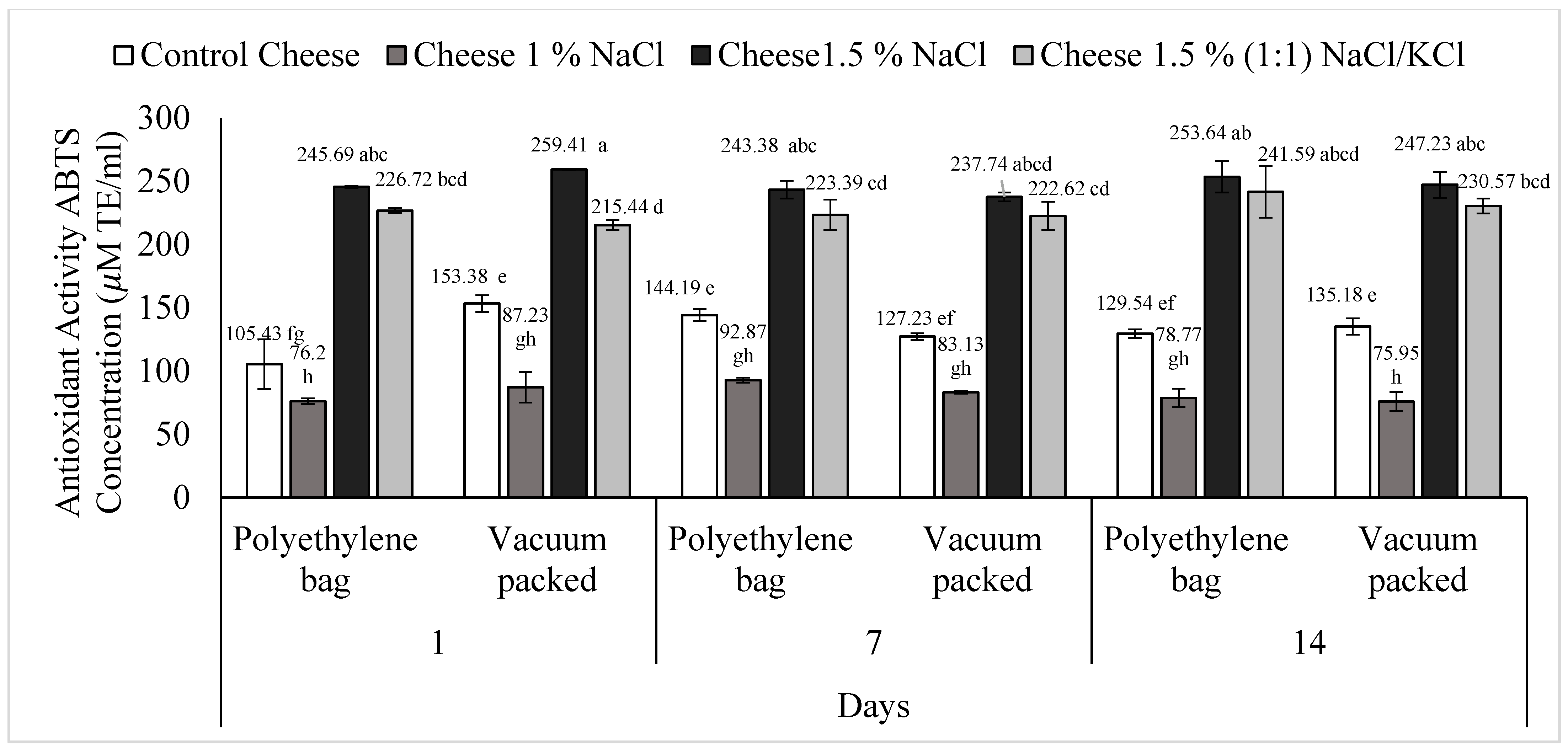
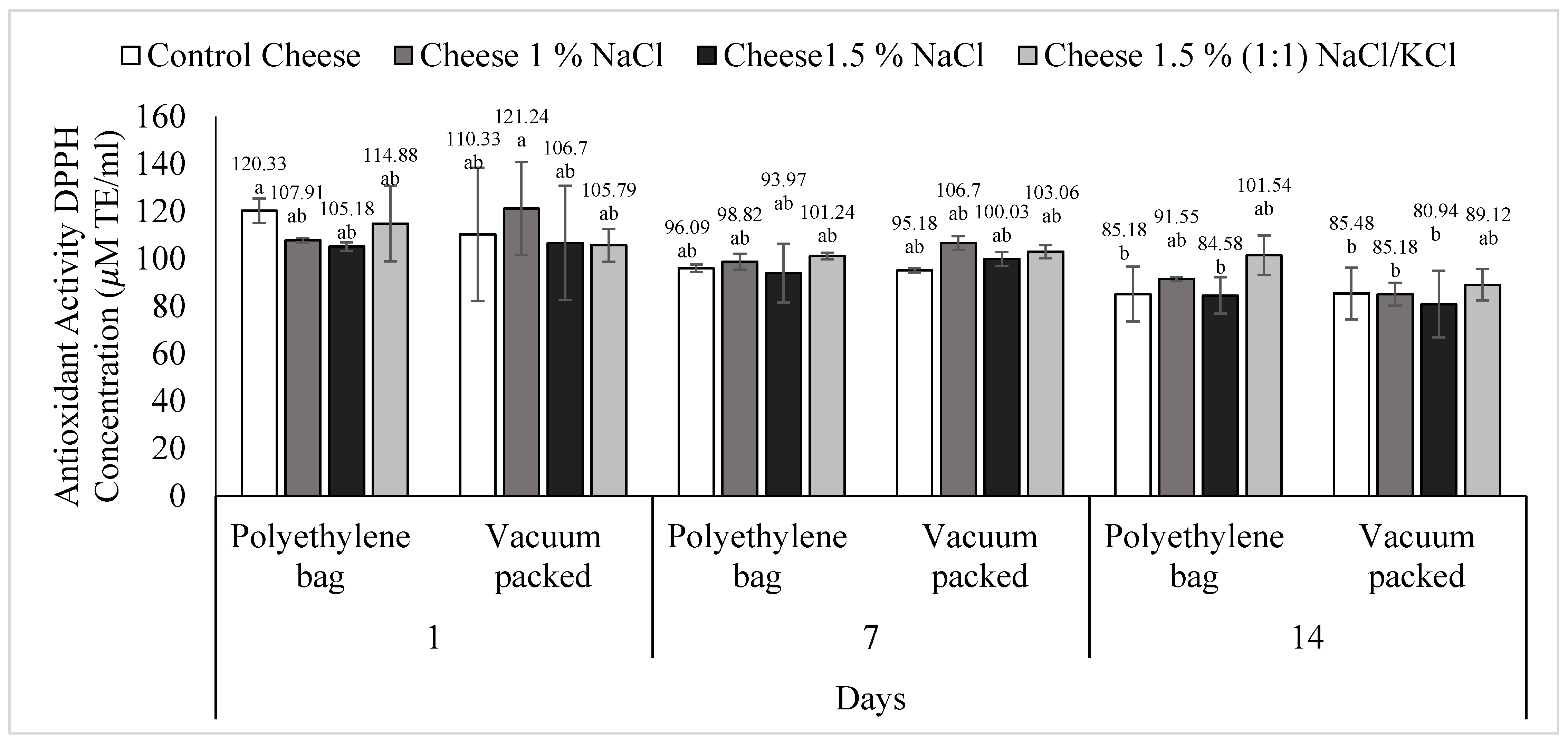
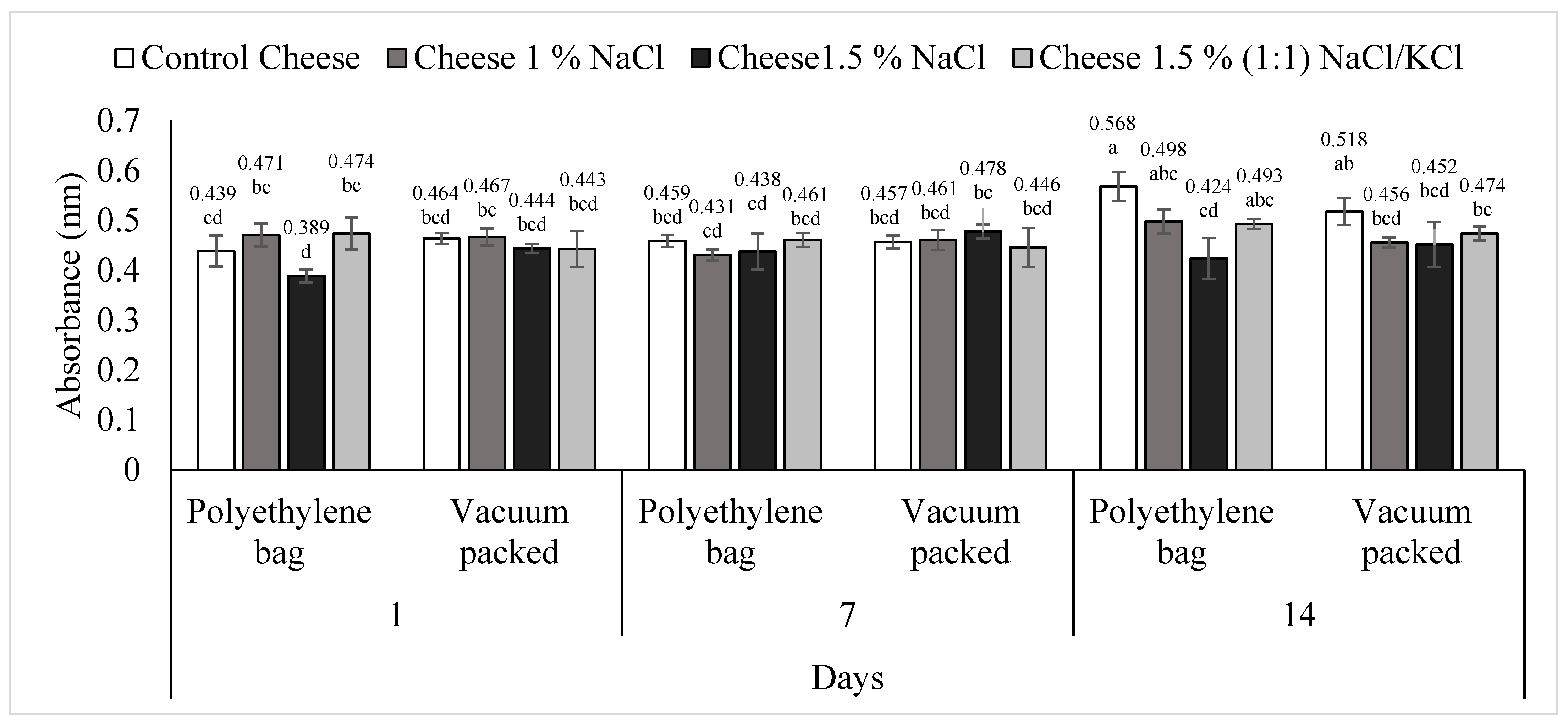
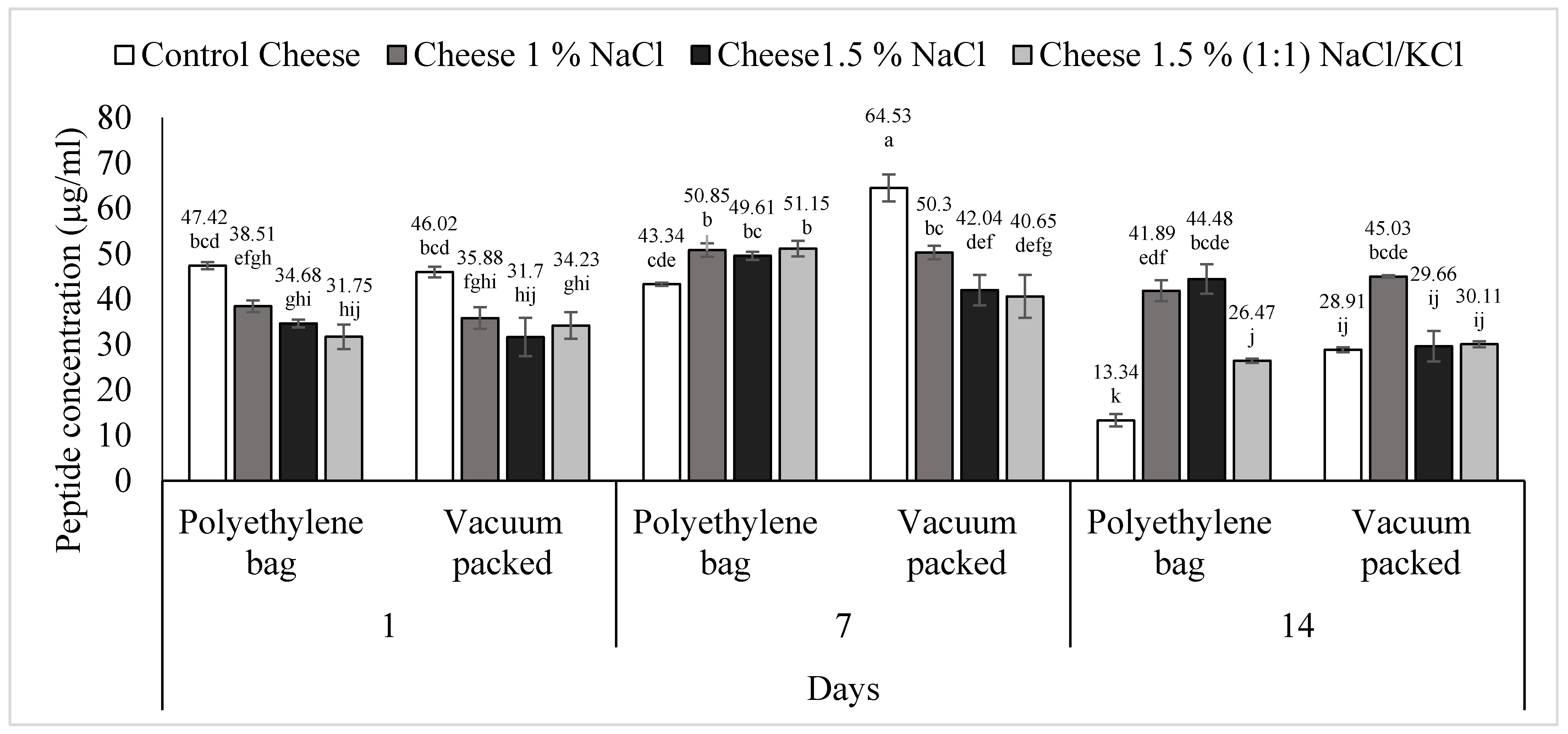
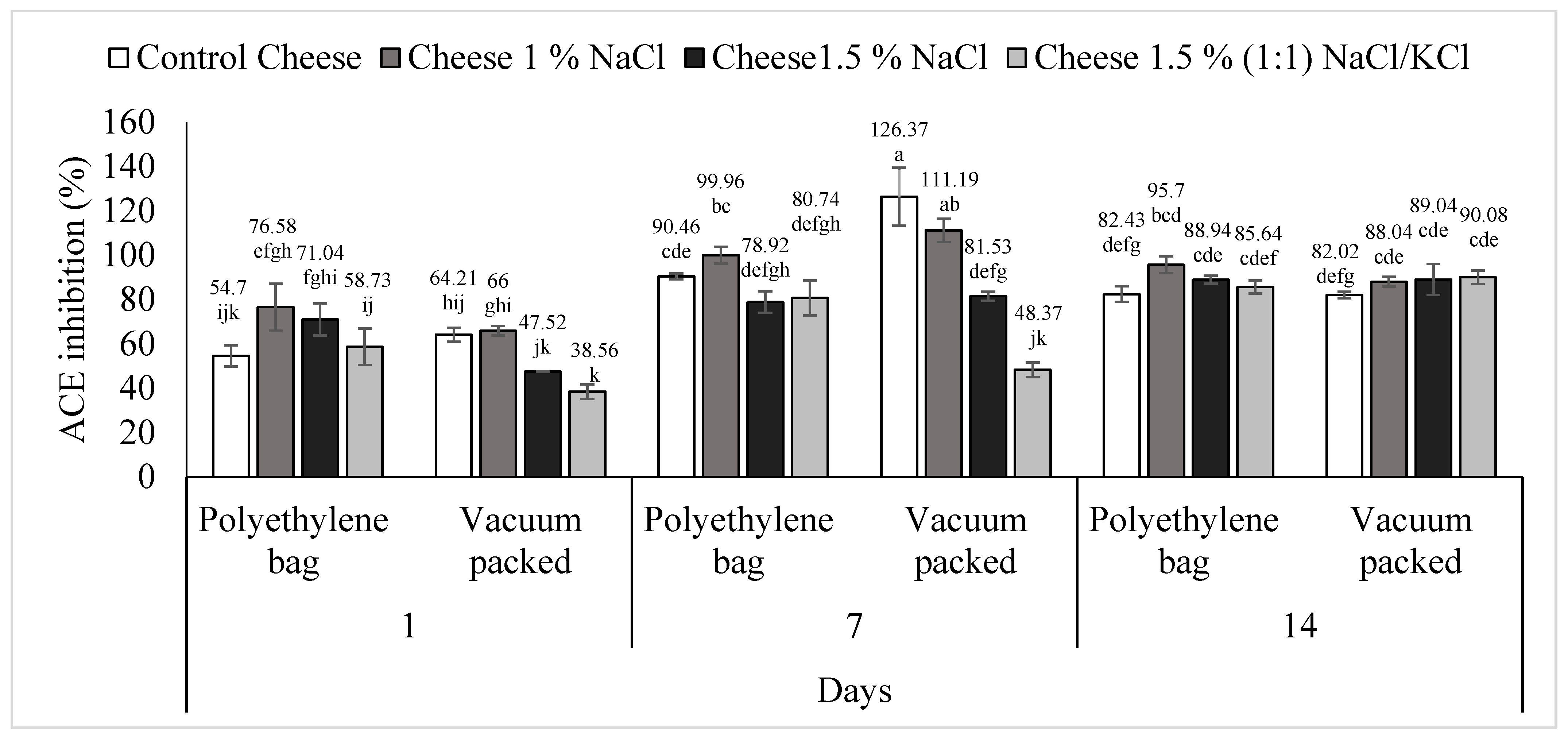
| Conventional Packed | |||||
|---|---|---|---|---|---|
| ABTS | DPPH | Proteolysis | PC | ACE | |
| ABTS | 1 | −0.516 | 0.314 | −0.200 | 0.840 |
| p-value | 0.154 | 0.409 | 0.605 | 0.004 | |
| DPPH | 1 | −0.699 | 0.746 | −0.794 | |
| p-value | 0.036 | 0.020 | 0.010 | ||
| Proteolysis | 1 | −0.940 | 0.398 | ||
| p-value | 0.000 | 0.288 | |||
| PC | 1 | −0.394 | |||
| p-value | 0.292 | ||||
| ACE | 1 | ||||
| Vacuum Packed | |||||
| ABTS | 1 | 0.547 | −0.136 | −0.268 | −0.832 |
| p-value | 0.127 | 0.727 | 0.4847 | 0.005 | |
| DPPH | 1 | −0.371 | 0.236 | −0.236 | |
| p-value | 0.325 | 0.539 | 0.539 | ||
| Proteolysis | 1 | −0.801 | −0.331 | ||
| p-value | 0.009 | 0.383 | |||
| PC | 1 | 0.685 | |||
| p-value | 0.041 | ||||
| ACE | 1 | ||||
| Conventional Packed | |||||
|---|---|---|---|---|---|
| ABTS | DPPH | Proteolysis | PC | ACE | |
| ABTS | 1 | −0.178 | −0.718 | 0.836 | 0.569 |
| p-value | 0.645 | 0.029 | 0.005 | 0.109 | |
| DPPH | 1 | −0.285 | −0.323 | −0.689 | |
| p-value | 0.457 | 0.39 | 0.039 | ||
| Proteolysis | 1 | −0.664 | −0.015 | ||
| p-value | 0.050 | 0.96 | |||
| PC | 1 | 0.724 | |||
| p-value | 0.027 | ||||
| ACE | 1 | ||||
| Vacuum Packed | |||||
| ABTS | 1 | 0.177 | 0.233 | −0.167 | −0.2060 |
| p-value | 0.648 | 0.546 | 0.667 | 0.594 | |
| DPPH | 1 | 0.169 | −0.512 | −0.297 | |
| p-value | 0.663 | 0.158 | 0.436 | ||
| Proteolysis | 1 | −0.139 | −0.314 | ||
| p-value | 0.72 | 0.409 | |||
| PC | 1 | 0.939 | |||
| p-value | 0.000 | ||||
| ACE | 1 | ||||
| Conventional packed | |||||
|---|---|---|---|---|---|
| ABTS | DPPH | Proteolysis | PC | ACE | |
| ABTS | 1 | −0.164 | 0.026 | 0.023 | 0.269 |
| p-value | 0.672 | 0.945 | 0.952 | 0.483 | |
| DPPH | 1 | −0.626 | −0.593 | 0.715 | |
| p-value | 0.071 | 0.091 | 0.030 | ||
| Proteolysis | 1 | 0.747 | 0.353 | ||
| p-value | 0.020 | 0.350 | |||
| PC | 1 | 0.461 | |||
| p-value | 0.211 | ||||
| ACE | 1 | ||||
| Vacuum packed | |||||
| ABTS | 1 | 0.349 | −0.754 | −0.610 | −0.649 |
| p-value | 0.355 | 0.018 | 0.080 | 0.050 | |
| DPPH | 1 | −0.347 | −0.032 | −0.463 | |
| p-value | 0.358 | 0.934 | 0.209 | ||
| Proteolysis | 1 | 0.529 | 0.194 | ||
| p-value | 0.142 | 0.616 | |||
| PC | 1 | 0.115 | |||
| p-value | 0.766 | ||||
| ACE | 1 | ||||
| Conventional packed | |||||
|---|---|---|---|---|---|
| ABTS | DPPH | Proteolysis | PC | ACE | |
| ABTS | 1 | 0.068 | 0.268 | −0.433 | 0.184 |
| p-value | 0.860 | 0.485 | 0.243 | 0.634 | |
| DPPH | 1 | −0.026 | −0.289 | −0.366 | |
| p-value | 0.946 | 0.450 | 0.331 | ||
| Proteolysis | 1 | −0.561 | 0.178 | ||
| p-value | 0.115 | 0.645 | |||
| PC | 1 | 0.109 | |||
| p-value | 0.780 | ||||
| ACE | 1 | ||||
| Vacuum packed | |||||
| ABTS | 1 | −0.489 | 0.233 | −0.156 | 0.665 |
| p-value | 0.180 | 0.545 | 0.687 | 0.050 | |
| DPPH | 1 | −0.594 | 0.617 | −0.875 | |
| p-value | 0.091 | 0.076 | 0.002 | ||
| Proteolysis | 1 | −0.608 | 0.487 | ||
| p-value | 0.081 | 0.183 | |||
| PC | 1 | −0.604 | |||
| p-value | 0.084 | ||||
| ACE | 1 | ||||
| ABTS | DPPH | Proteolysis | PC | ACE | |
|---|---|---|---|---|---|
| ABTS˙ | 1 | −0.0868 | −0.2461 | −0.2546 | −0.3339 |
| p-value | 0.4683 | 0.0371 | 0.0309 | 0.0042 | |
| DPPH˙ | 1 | −0.2536 | 0.0853 | −0.3779 | |
| p-value | 0.0316 | 0.4761 | 0.0011 | ||
| Proteolysis | 1 | −0.4375 | 0.1300 | ||
| p-value | 0.0001 | 0.2763 | |||
| PC | 1 | 0.3644 | |||
| p-value | 0.0016 | ||||
| ACE | 1 | ||||
| p-value |
Publisher’s Note: MDPI stays neutral with regard to jurisdictional claims in published maps and institutional affiliations. |
© 2022 by the authors. Licensee MDPI, Basel, Switzerland. This article is an open access article distributed under the terms and conditions of the Creative Commons Attribution (CC BY) license (https://creativecommons.org/licenses/by/4.0/).
Share and Cite
Ramírez-Rivas, I.K.; Gutiérrez-Méndez, N.; Rentería-Monterrubio, A.L.; Sánchez-Vega, R.; Tirado-Gallegos, J.M.; Santellano-Estrada, E.; Arevalos-Sánchez, M.M.; Chávez-Martínez, A. Effect of Packaging and Salt Content and Type on Antioxidant and ACE-Inhibitory Activities in Requeson Cheese. Foods 2022, 11, 1264. https://doi.org/10.3390/foods11091264
Ramírez-Rivas IK, Gutiérrez-Méndez N, Rentería-Monterrubio AL, Sánchez-Vega R, Tirado-Gallegos JM, Santellano-Estrada E, Arevalos-Sánchez MM, Chávez-Martínez A. Effect of Packaging and Salt Content and Type on Antioxidant and ACE-Inhibitory Activities in Requeson Cheese. Foods. 2022; 11(9):1264. https://doi.org/10.3390/foods11091264
Chicago/Turabian StyleRamírez-Rivas, Ivette Karina, Néstor Gutiérrez-Méndez, Ana Luisa Rentería-Monterrubio, Rogelio Sánchez-Vega, Juan Manuel Tirado-Gallegos, Eduardo Santellano-Estrada, Martha María Arevalos-Sánchez, and América Chávez-Martínez. 2022. "Effect of Packaging and Salt Content and Type on Antioxidant and ACE-Inhibitory Activities in Requeson Cheese" Foods 11, no. 9: 1264. https://doi.org/10.3390/foods11091264
APA StyleRamírez-Rivas, I. K., Gutiérrez-Méndez, N., Rentería-Monterrubio, A. L., Sánchez-Vega, R., Tirado-Gallegos, J. M., Santellano-Estrada, E., Arevalos-Sánchez, M. M., & Chávez-Martínez, A. (2022). Effect of Packaging and Salt Content and Type on Antioxidant and ACE-Inhibitory Activities in Requeson Cheese. Foods, 11(9), 1264. https://doi.org/10.3390/foods11091264








